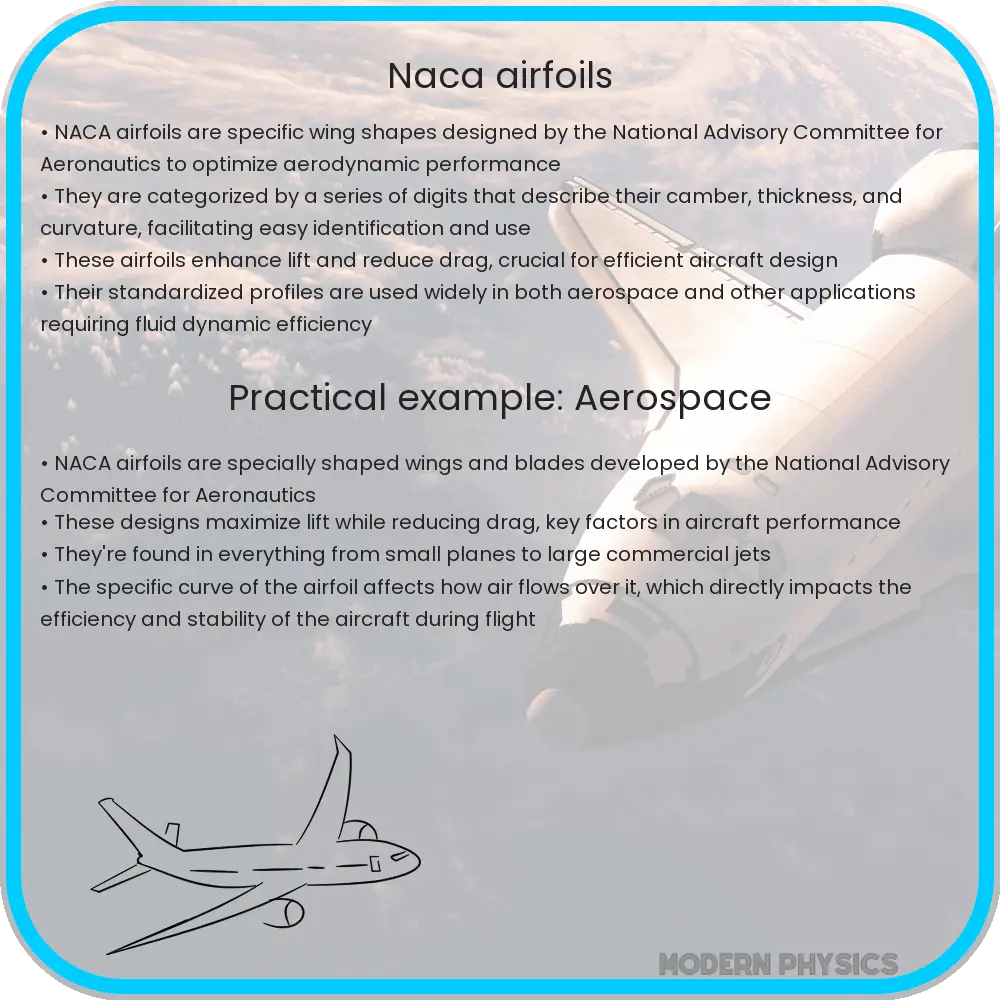Learn about NACA airfoils, key elements in aerodynamics used to optimize aircraft performance by balancing lift and drag effectively.

Understanding NACA Airfoils
The term “NACA airfoils” refers to a series of airfoil shapes developed by the National Advisory Committee for Aeronautics (NACA) to optimize performance in a variety of flight conditions. NACA airfoils are fundamental to modern aerodynamics and are used in a wide range of aircraft to achieve optimal lift, low drag, and overall efficiency.
Principles of Airfoil Design
At the heart of airfoil design is the shape and size of the wing’s cross-section, which directly influences the airflow and thus the flying characteristics of an aircraft. An airfoil design aims to maximize lift, which is the force that pushes the wing upward and counters gravity, while minimizing drag, the resisting force exerted by air opposing the aircraft’s motion.
The efficiency of an airfoil is measured by its lift-to-drag ratio. A higher ratio indicates that the airfoil can generate more lift for less drag, which is ideal for performance.
The NACA Series
The NACA airfoils were derived from extensive testing and mathematical formulas. These airfoils are categorized into different series, each tailored for specific aerodynamic properties. Common among these are the NACA 4-digit, 5-digit, and 6-series airfoils.
- NACA 4-digit airfoils – These are described using four digits that denote the camber, position of maximum camber, and thickness of the airfoil. For instance, a NACA 2412 airfoil has a maximum camber of 2% located 40% from the leading edge, with a thickness of 12% of the chord.
- NACA 5-digit airfoils – Developed to reduce drag at high angles of attack, the 5-digit series provides more refined control over the camber line for improved lift characteristics.
- NACA 6-series airfoils – These offer further optimization for specific aerodynamic conditions and are known for their ability to delay boundary layer separation, thus enhancing performance and control at higher flight speeds.
Applications and Impact
NACA airfoils have significantly influenced the design of both civilian and military aircraft. Due to their versatile and predictable aerodynamic properties, these airfoils can be tailored to meet the specific needs of different types of aircraft, from gliders and small personal airplanes to large commercial jets.
The impact of NACA research extends beyond simple airfoil shapes. The principles derived from their studies have informed broader advancements in aerodynamic theory and practice, laying the groundwork for the complex computational fluid dynamics (CFD) models used in modern aerospace engineering.
Lift and Drag: The Aerodynamic Balancing Act
Lift and drag are two fundamental forces that any airfoil design must balance effectively. Lift is generated primarily by the interaction between the air and the airfoil’s upper surface, which is curved to create a pressure difference. As air moves over the upper surface, its speed increases, which decreases its pressure relative to the slower air moving underneath the wing. This pressure difference results in an upward lift force.
Meanwhile, drag arises due to friction between the air and the wing’s surface, as well as from the pressure differential leading to vortex formation at the wingtips. The challenge for airfoil designers is to maximize lift while minimizing drag, a critical factor in determining the efficiency, speed, and maneuverability of an aircraft.
Through its innovative series, NACA has successfully addressed these challenges, creating airfoils that enhance the lift-to-drag ratio and improve overall aircraft performance. In following segments, we will delve deeper into the mathematical modeling of NACA airfoils and explore their practical applications in current aerospace design.
Mathematical Modeling of NACA Airfoils
Understanding the mathematical foundation behind NACA airfoils is crucial for both designing new airfoils and analyzing existing ones. The geometry of a NACA airfoil is typically generated using polynomial equations that define the camber (curvature) of the airfoil along its chord (horizontal length).
For example, the simple expression for a NACA 4-digit airfoil’s mean line, or camber line, might look like: y = 0.6*(0.2969*sqrt(x) – 0.1260*x – 0.3516*x2 + 0.2843*x3 – 0.1015*x4), where x is the position along the chord from 0 to 1. This formula helps calculate the vertical position (y) of the camber line at any point along the chord.
The thickness distribution, which is symmetric about the camber line, is also defined by a series of polynomial terms, allowing engineers to precisely model the airfoil’s shape.
Practical Applications in Aerospace Design
The practical applications of NACA airfoils are vast and varied. In commercial aviation, the NACA airfoil profiles help optimize the performance of the aircraft by improving the aerodynamic efficiency which is crucial for fuel economy. In military aircraft, the ability to sustain higher speeds with efficient control is often derived from advanced NACA airfoil designs.
Moreover, in the field of renewable energy, NACA airfoils are utilized in the design of wind turbine blades to maximize efficiency and generate more power. The principles of lift generating minimal drag are apply effectively in this context, demonstrating the adaptability of NACA airfoil designs across different industries.
Conclusion
NACA airfoils represent a cornerstone technology in the field of aerodynamics, influencing the design and efficiency of various craft in air and possibly in water. From the basic principles of lift and drag to the complex computational models used to simulate these phenomena, the development of NACA airfoils has been a significant advancement. Academics, engineers, and designers continually rely on the principles pioneered by NACA to push the boundaries of what modern engineering can achieve in the aerospace and other related industries.
As we continue to explore and understand these fundamental engineering components, their potential applications and impact on modern technology seem boundless. With ongoing research and development, the future of NACA airfoils and their derivatives is poised to influence further innovation in aerodynamics and fluid dynamics on a global scale.
